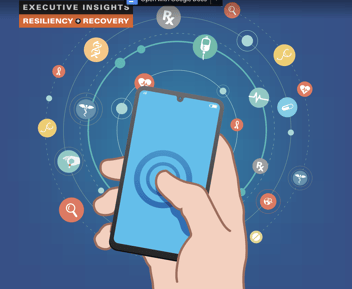In spring 2022, Gozio sponsored an AHA Executive Dialog, Redefining the Digital Front Door for a Frictionless Health Care Experience. A group of 12 healthcare leaders convened to talk about how they define the digital front door. The first question the group was asked was, "How does your organization define health care’s digital front door and its role in creating a consistent consumer experience?"
Here are answers from six of the attendees:
MARCIA DIAZ DE VILLEGAS (Nicklaus Children’s Health System): We are similarly embarking on a digital front door led by our IT team. We’re really looking to make a frictionless experience where the consumer can either use our online scheduling, which is in a nascent phase, or the customer call center, which we’ve had for several years. Folks can complete forms on the website. We work with our digital ad agency to look at what happens to those people who are completing an online form.
For our physician enterprise, we have ambitious goals to get patient appointments within a reasonable time frame which, nationally, is a challenge for certain service lines. Historically, if customers can’t obtain an appointment within a two-week window, they drop off. We’re trying to get a handle on the revenue that we’re losing in those areas. Telehealth has really helped us. Like most organizations, the consumer adoption was overnight. That’s an area in which we’re continuing to focus.
TONI DONOVAN (Penn Medicine Lancaster General Health): We’re looking to provide patients’ access through any door, whether it’s the front door, side door or the back door, to provide equitable access to those we serve. We already have online access for many, but not all, services. Every care point needs be simple for patients to access with their own technology that is also easy to manage. We have pulled together information technology (IT), marketing, operations and our clinicians into project
teams to organize and attack this from all angles.
BEN MAISANO (Atlantic Health System): A unified and consumer-grade digital front door that improves access, navigation and personalization is one of the top priorities for Atlantic Health. We’re defining the digital front door as a differentiated logged-in experience beyond MyChart, but well-integrated into Epic. A utility feel is not just for guests and patients in our care, but the evolution of guests to consumers and evolution of patients to memberships with the ability to start digital.
It must be convenient; convenience drives loyalty. That means we have to have family views, guiding wizard flows for symptoms, scheduling and referrals; digital itineraries for complex care journeys with an understanding of the medical record; and asynchronous communication channels that are flexible coupled with automated outreach to start engagements. It’s a whole new façade on a great health system.
COURTNEY STARNES (Saint Luke’s Health System): One of our top initiatives for this year, and probably for the next several years, is around the digital patient experience. We didn’t want to just look at the front door. We wanted to look at the entire house.
It’s an important initiative for us, and we’ve engaged folks from marketing, clinical operations and revenue cycle. We are also engaging our patients in the project as well.
We put together the patient experience compass to express our vision for patient experience. The patient is at the center of the compass. The quadrants are whether the patient is at home, whether the patient is in a clinic or a hospital and whether the patient is well or ill. We are looking at the entire experience of where that patient, that community member is and how we can better serve them.
The focus is on increasing patient self-engagement to improve outcomes and to make sure that all our experiences with patients are consistent.
ZACHARY CHANDLER (Baptist Memorial Health Care Corporation): It’s about developing digital journeys and digital relationships. We view digital as just being a communication vehicle that allows customers to engage the health system for transactions or services, whether it’s with your business teams, clinical teams or marketing teams, even how they access and learn about services.
We want to build a unique customer experience and have engaged relationships ultimately leading to valuable information to guide the delivery and future journeys for our patients.
This was just one of the many topics discussed during this Executive Dialog. For more insights from leaders across healthcare, download the complete report.
Epic is a registered trademark of Epic Systems Corporation.


